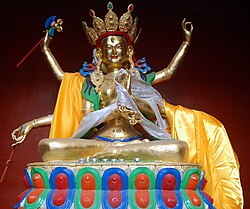Religion:Parnashavari
Parnashavari (IAST: Parṇaśabarī, Sanskrit: पर्णशबरी), also spelt as Paranasavari (Paranasabari),[1][2] is a Hindu deity adopted as Buddhist deity of diseases, worship of which is believed to offer effective protection against out-breaks of epidemics.[3]
Parnasabari is also depicted in some images of the Pala period found in Dhaka, as a main goddess and escorted by Hindu deities Jvarasura and Shitala.[4] Both of these escorts are disease related Hindu deities.[4] In India, the Kurkihar hoard contains seven bronze images of Parnasabari belonging to 10th–12th century AD.[5]
In Buddhism, Parnasabari is depicted as an attendant of the Buddhist deity of same name, Tara.[1] Some say that the term Parnasabari is an attempt to connect the deity with Vindya region, as Sabaras held a stronghold over the region.[1]
References
- ↑ 1.0 1.1 1.2 Reflections on the Tantras. S̄udhakar Chattopadhyaya. 1978. pp. 76. ISBN 9788120806917. https://books.google.com/books?id=CmaewdodLZQC&q=Paranasabari&pg=PA76.
- ↑ The social function of art by Radhakamal Mukerjee. Philosophical Library. 1954. pp. 151. ISBN 9780802211682. https://books.google.com/books?id=Vh4sAQAAIAAJ&q=paranasavari.
- ↑ Bhattacharyya, Benoytosh (1958). The Indian Buddhist Iconography art. pp. 520. ISBN 9788173053139. https://www.wisdomlib.org/buddhism/book/the-indian-buddhist-iconography/d/doc243227.html.
- ↑ 4.0 4.1 Studies in Hindu and Buddhist art. By P. K. Mishra. 1999. pp. 107. ISBN 9788170173687. https://books.google.com/books?id=AqSAQpCOifoC&q=parnasabari&pg=RA1-PA107.
- ↑ History of the tantric religion: a historical, ritualistic, and philosophical study. Narendra Nath Bhattacharyya. 1982. pp. 394. ISBN 9788173040252. https://books.google.com/books?id=t3cIAQAAIAAJ&q=Paranasabari.
 |


